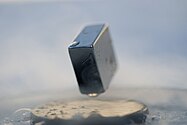| Condensed matter experiments |
|---|

|
| ARPES |
| ACAR |
| Neutron scattering |
| X-ray spectroscopy |
| Quantum oscillations |
| Scanning tunneling microscopy |
In condensed matter physics, quantum oscillations describes a series of related experimental techniques used to map the Fermi surface of a metal in the presence of a strong magnetic field.[1] These techniques are based on the principle of Landau quantization of Fermions moving in a magnetic field.[2] For a gas of free fermions in a strong magnetic field, the energy levels are quantized into bands, called the Landau levels, whose separation is proportional to the strength of the magnetic field. In a quantum oscillation experiment, the external magnetic field is varied, which causes the Landau levels to pass over the Fermi surface, which in turn results in oscillations of the electronic density of states at the Fermi level; this produces oscillations in the many material properties which depend on this, including resistance (the Shubnikov–de Haas effect), Hall resistance,[2] and magnetic susceptibility (the de Haas–van Alphen effect). Observation of quantum oscillations in a material is considered a signature of Fermi liquid behaviour.[3]
Quantum oscillations have been used to study high temperature superconducting materials such as cuprates and pnictides.[1] Studies using these experiments have shown that the ground state of underdoped cuprates behave similar to a Fermi liquid, and display characteristics such as Landau quasiparticles.[4]
In 2021 this technique has been used to observe a predicted state called "electron–phonon fluid",[5][6] a similar particle-quasiparticle state already known is the exciton–polariton fluid.
- ^ a b Coldea, Amalia (2010). "Quantum oscillations probe the normal electronic states of novel superconductors". Philosophical Transactions of the Royal Society A. 368 (1924): 3503–3517. Bibcode:2010RSPTA.368.3503C. doi:10.1098/rsta.2010.0089. PMID 20603364. Retrieved 20 March 2012.
- ^ a b Doiron-Leyraud, Nicolas; et al. (2007). "Quantum oscillations and the Fermi surface in an underdoped high-Tc superconductor". Nature. 447 (7144): 565–8. arXiv:0801.1281. Bibcode:2007Natur.447..565D. doi:10.1038/nature05872. PMID 17538614. S2CID 4397560.
- ^ Condensed-matter and materials physics: the science of the world around us. National Research Council. 2010. ISBN 978-0-309-13409-5.
- ^ Broun, D. M. (2008). "What lies beneath the dome?". Nature Physics. 4 (3): 170–172. Bibcode:2008NatPh...4..170B. doi:10.1038/nphys909.
- ^ Yang, Hung-Yu; Yao, Xiaohan; Plisson, Vincent; Mozaffari, Shirin; Scheifers, Jan P.; Savvidou, Aikaterini Flessa; Choi, Eun Sang; McCandless, Gregory T.; Padlewski, Mathieu F.; Putzke, Carsten; Moll, Philip J. W. (2021-09-06). "Evidence of a coupled electron-phonon liquid in NbGe2". Nature Communications. 12 (1): 5292. arXiv:2103.01515. Bibcode:2021NatCo..12.5292Y. doi:10.1038/s41467-021-25547-x. ISSN 2041-1723. PMC 8421384. PMID 34489411.
- ^ College, Boston (2021-09-06). "Novel Metal Discovered Where Electrons Flow in the Same Way Water Flows in a Pipe". SciTechDaily. Retrieved 2021-09-20.
© MMXXIII Rich X Search. We shall prevail. All rights reserved. Rich X Search
